The Weird of Oz Locates Scooby-Doo
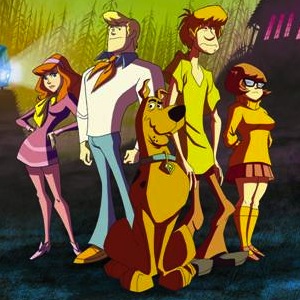 “Scooby Dooby Doo, where are you?” is a question I’ve heard asked — or, rather, sung — ever since I was a child. For most of my life, I didn’t care where the hell he was. But things have changed.
“Scooby Dooby Doo, where are you?” is a question I’ve heard asked — or, rather, sung — ever since I was a child. For most of my life, I didn’t care where the hell he was. But things have changed.
Scooby-Doo and the Mystery Inc. gang have been unmasking criminal hoaxers longer than I’ve been around, having debuted three years before I was born. They belong to that collective mob of pop-culture figures that have just always been there and are still going strong performing their antics for new generations…Looney Tunes, Mickey Mouse and his club, the Muppets, the Peanuts Gang, Tom and Jerry. Others from my childhood have fallen by the wayside — Heckle and Jeckle, Woody Woodpecker — waiting to be re-launched or else forever consigned to the Old Toons Retirement Home.
As a boy, I followed all of them at one time or another. This was largely determined by which programs the networks happened to be running during the hours just before or just after school (and, of course, that golden block of children’s programming: Saturday morning). It may be almost unfathomable to some of my younger readers, but there was a time not all that long ago when a latchkey kid getting home from school only had three or four channels to choose from, perhaps only one of which would be playing cartoons — two channels if you were lucky, in which case you might actually have a choice between, say, Care Bears or He-Man and the Masters of the Universe (and you can guess which one I chose). For us, the idea of six or seven channels playing cartoons 24/7 would seem about as far off as some of the far-out gadgetry on Star Trek.
Scooby-Doo is one of the franchises that has had real staying power, obviously. Unlike, say, The Flintstones, the live-action movies did not kill the franchise, which has gone through numerous new incarnations of TV series as well as dozens of made-for-TV or direct-to-video animated films.
I saw most of the original three seasons of Scooby-Doo Where Are You! when they were running in syndication back in the ‘70s, but my feelings about the series quickly became ambivalent. By the ‘80s, I had developed a strong dislike for the show. As an adult, if I saw an old episode come on, it did not even engender a touch of that nostalgic charm that infuses so much of the pop culture we recall from our halcyon days of youth.
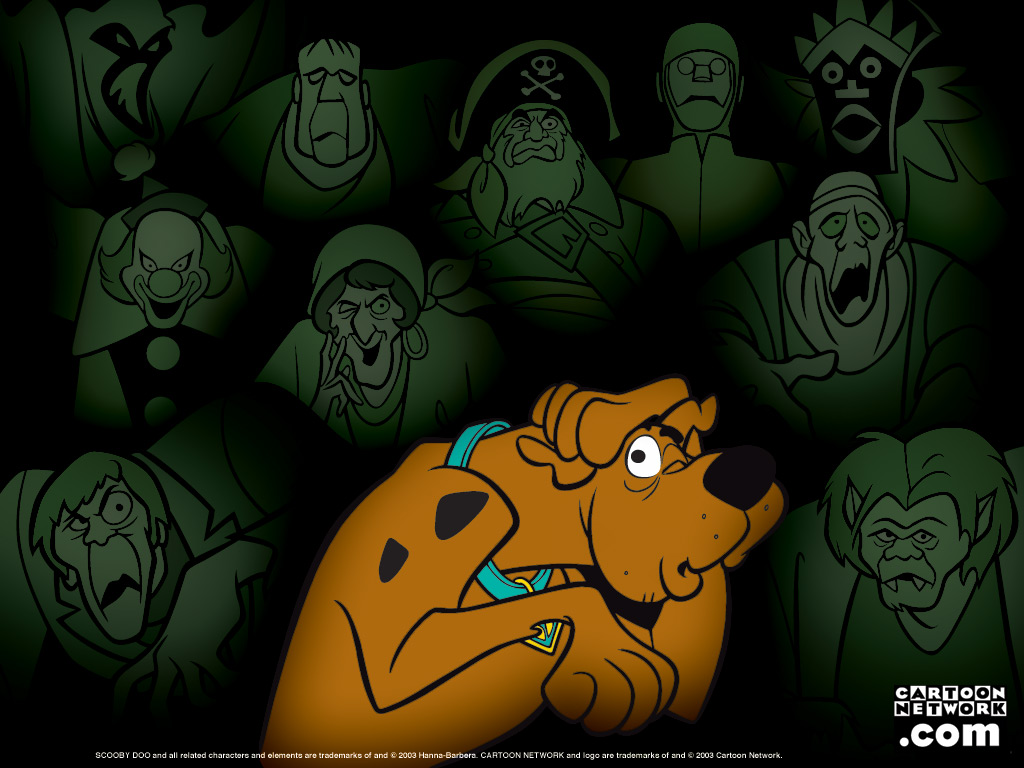 Probably what turned me off from the original series was part-and-parcel with what originally drew me to it: the monsters. It’s no secret to regular readers that I have always been a monster fan, and Scooby-Doo purported to serve up a new one each day, often pretty scary and cool-looking ones. The letdown, of course, came from the fact that there were, in fact, no monsters at all — at the end of every episode, the monster was unmasked to reveal Old Man Smithers or some other bitter geriatric would-be criminal, which really raised the question of how they were able to perform such near-superhuman feats of strength and dexterity in their cumbersome costumes. Hey, it was only a cartoon — but for a cartoon that so thoroughly espoused a naturalistic explanation for its haunts and that sided with cold, rational science in declaring that monsters do not exist, wasn’t it odd that no one questioned the existence of a talking dog?
Probably what turned me off from the original series was part-and-parcel with what originally drew me to it: the monsters. It’s no secret to regular readers that I have always been a monster fan, and Scooby-Doo purported to serve up a new one each day, often pretty scary and cool-looking ones. The letdown, of course, came from the fact that there were, in fact, no monsters at all — at the end of every episode, the monster was unmasked to reveal Old Man Smithers or some other bitter geriatric would-be criminal, which really raised the question of how they were able to perform such near-superhuman feats of strength and dexterity in their cumbersome costumes. Hey, it was only a cartoon — but for a cartoon that so thoroughly espoused a naturalistic explanation for its haunts and that sided with cold, rational science in declaring that monsters do not exist, wasn’t it odd that no one questioned the existence of a talking dog?
As I got older and developed a more sophisticated appreciation for good animation, I disdained the cheap, static, lo-tech animation style — when characters were standing around talking, only their lips would move. Hanna-Barbera was serving up bargain-basement stuff on restrictive budgets (although in retrospect, the backgrounds were well done — evocative and spooky — and the character design, especially the monsters, was good). Plus I could just never get over the disappointment, time after time, of each monster invariably being revealed as a fraud.
I forgot about Scooby-Doo. Had zero interest in the live-action film when it was thrust upon multiplexes (the CGI design of Scooby-Doo is a travesty I find painful to look at. And could Fred have been more miscast?). It would have been forever relegated to a dusty file in the back cabinets of my memory, along with Disney’s Adventures of the Gummi Bears and The Herculoids and other shows I occasionally saw as a child.
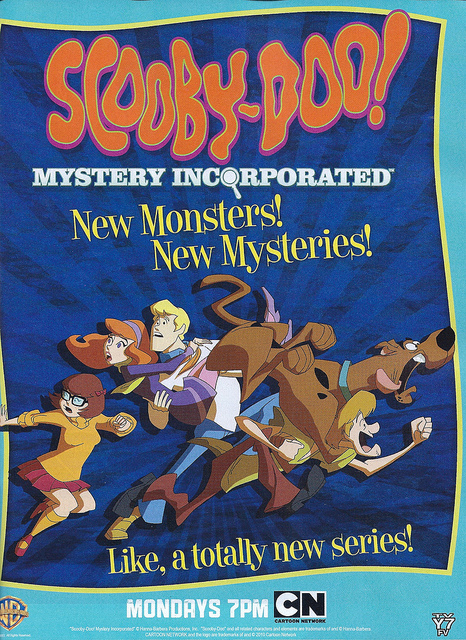 But then something happened. I went and had kids. And through my three-year-old daughter I rediscovered Scooby-Doo. Or rather, I discovered that there is a new Scooby-Doo, launched by Warner Brothers (which bought out Hanna-Barbera) on Cartoon Network in 2010. Now two seasons in, this revamped Mystery Inc. gang is cool. Scooby-Doo! Mystery Incorporated is hip, witty, leavened with parody and satire, and it’s a post-Buffy show (for an explanation of what I mean by “post-Buffy,” see next week’s post).
But then something happened. I went and had kids. And through my three-year-old daughter I rediscovered Scooby-Doo. Or rather, I discovered that there is a new Scooby-Doo, launched by Warner Brothers (which bought out Hanna-Barbera) on Cartoon Network in 2010. Now two seasons in, this revamped Mystery Inc. gang is cool. Scooby-Doo! Mystery Incorporated is hip, witty, leavened with parody and satire, and it’s a post-Buffy show (for an explanation of what I mean by “post-Buffy,” see next week’s post).
Here’s what happened, I think: People like you and me started writing the show.
All the basic elements are there for the kids — Shaggy and Scooby stuffing their gullets with enough junk food to inflict cardiovascular disease on the entire population of a small town, Fred making his traps, Velma finding clues, Daphne getting into damsel-in-distress scrapes, Shaggy yelling “Zoinks!” while he and Scooby quiver and panic at the mention of ghosts; chases and hi-jinks galore. And scary looking monsters (which, yes, are still inevitably revealed as fakes). To underscore that the new episodes still work on that level, my daughter makes no distinction between the new shows and older ones we’ve collected on DVD to feed her Scooby-Snack appetite.
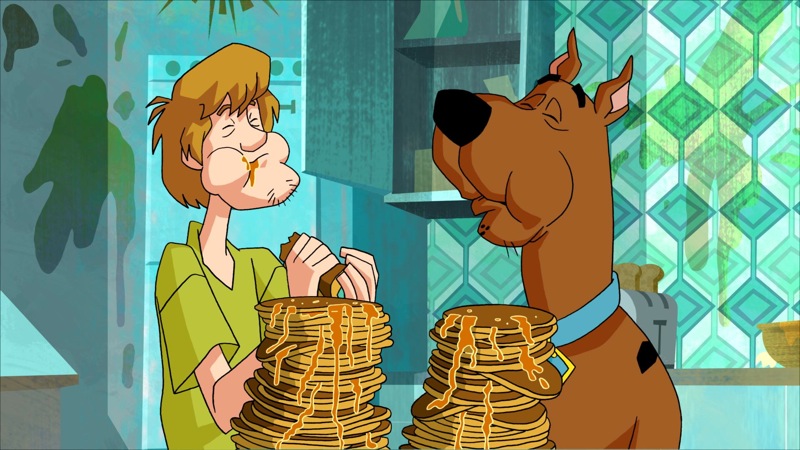 But what she doesn’t realize is that her daddy is sitting on the couch beside her laughing hysterically not because of any of those tropes. He’s amused because the people writing this are also (perhaps primarily) writing it for people like him. It is laden with references and allusions of the sort that regular attendees of fantasy, horror, and sci-fi conventions will most appreciate. Just off the top of my head, a few examples: H.P. Lovecraft. Hellraiser. Jim Henson’s Labyrinth. Dungeons & Dragons (not just a broad reference to the game, mind you, of the sort anyone would get including those who never played it, but references to 20-sided dice, magic missile, saving throws, and critical hits!). Harlan Ellison (who even appears in an episode, voicing himself — a far cry from the days when the guest-voices were the Harlem Globetrotters).
But what she doesn’t realize is that her daddy is sitting on the couch beside her laughing hysterically not because of any of those tropes. He’s amused because the people writing this are also (perhaps primarily) writing it for people like him. It is laden with references and allusions of the sort that regular attendees of fantasy, horror, and sci-fi conventions will most appreciate. Just off the top of my head, a few examples: H.P. Lovecraft. Hellraiser. Jim Henson’s Labyrinth. Dungeons & Dragons (not just a broad reference to the game, mind you, of the sort anyone would get including those who never played it, but references to 20-sided dice, magic missile, saving throws, and critical hits!). Harlan Ellison (who even appears in an episode, voicing himself — a far cry from the days when the guest-voices were the Harlem Globetrotters).
Many of these allusions are so subtly embedded that you or I will catch them while some — perhaps a majority of — viewers will remain oblivious. They will follow the overarching plot while these clever little gems sail harmlessly over their heads. If I can find the time, I might do a few posts examining individual episodes in more detail, chronicling all the references I spot — an annotated Scooby-Doo, if you will.
Also, all those elements of the original series that were so ludicrous are not overlooked: like how some embittered old farmer in a rubber mask could fool everybody by leaping over rooftops and busting through walls? Or how the characters never aged? Or how, despite their insistence on the scientific method, they never batted an eye at Scooby’s anthropomorphism? It’s all fodder now for self-referential jokes. This self-parody manifests, for instance, in the elaborately tongue-in-cheek explanations of how the criminals (almost) pulled off their capers: enrolling for four years in mechanical engineering school and spending hundreds of thousands of dollars to design a monster suit’s hydraulics, all to get revenge for a city zoning ordinance that shut down a crab shack. These writers are having fun doing these shows, and I’m a little envious. But I’m also now a Scooby-Doo fan. If it continues in this vein, I hope the Mystery Inc. gang will still be around for my grandchildren.
The new series’s first season drew upon some familiar literary monsters like Lovecraft’s Cthulhu. In the second season, they have increasingly eschewed original monsters for ones drawn from myth and folklore (and some not-so-obvious ones): the Russian witch Baba Yaga with her hut that walks on chicken legs; Krampus, the satyr-like counterpart to Santa Claus that, in old Germanic legends, came Christmas Eve for the bad girls and boys. So now folklorists and scholars can jump on the bandwagon.
You can see why it appeals to me on so many levels: as the folklorist, the literary scholar, the table-top role-player, the comic-book reader, the spec-fic fan, the appreciator of good satire — it all adds up to a show that casts a positive patina back over those decades-old episodes I had grown to find so irritating. I can’t help but have a new appreciation for those now, because they led to this.
So, where is Scooby-Doo these days? He’s where it’s at.
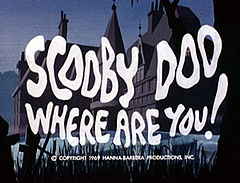
Great post. I’ve spent the last few weekends watching episodes of Mystery Inc and Buffy. A lot of the same themes pop up in both series.
Thanks Michael. Spending winter weekends watching Mystery Inc. and Buffy? That sounds awesome — much better than ice fishing, anyway.
I had written a paragraph about how Buffy obviously influenced these current Scooby-Doo scripters, but decided to hold that back for next Sunday’s post, where I’ll talk about what I mean when I say a series is “pre-Buffy” or “post-Buffy.” I hope you’ll check it out!
[…] and Mitch Watson). I’d read some very good things about the latter show, some here on this blog from Nick Ozment, so I decided I’d rewatch the series I knew from my youth and then see the modern reboot. Because […]